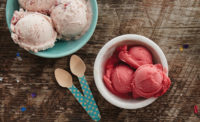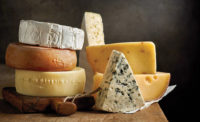
Staying Power
by Shonda Talerico Dudlicek
Shelf-stable products increase demands for the right
kinds of bottles, jugs and cartons.
It’s a new twist in
the battle of paper vs. plastic: How long will the product last? Which
yields a better surface for graphics? Can one offer something the other
can’t? And what can both offer to dairy processors and consumers?
Such is the current movement in the world of bottles,
jugs and cartons for dairy products.
“On the package side, the trends are for higher
barrier properties to be able to retain the nutritive value of the product
over longer distribution cycles,” says Jim Coe, vice president of
sales at Evergreen Packaging Equipment, Cedar Rapids, Iowa. “Barrier
structures are continually being developed and improved.”
Coe says shelf life is increasing in importance in
dairy operations. “The focus on high hygiene and food safety has
pushed the market into more sophisticated packaging machines that control
the environment around the filling process,” he says.
To lengthen shelf life, dairy processors have the
option of introducing ultra-high temperature pasteurization. This
technology requires special processing and a special container that allows
for non-refrigerated storage.
Batavia, Ill.-based Portola Packaging Inc. recently
formed a joint marketing agreement with Plastic Solutions Molding Inc.,
Plano, Texas. The companies will market technology, closures and bottles
that extend the shelf life of oxygen-sensitive products. The FDA-approved
and patent-pending technology retards the growth of bacteria, thus helping
to retain the quality of a product for a longer period of time.
Portola’s atypical ESL system can be implemented with simple
adaptations and is purported to extend the sell-by date by five to 10 days,
perhaps longer.
“Portola is very focused on delivering superior
closures, bottles and technical service to help our customer’s
achieve their packaging objectives,” says Brian Bauerbach,
Portola’s president and chief executive officer. “Now we can
offer a technology that extends the shelf life of oxygen-sensitive
products. This alliance is one more way that Portola can provide a total
solution to dairy customers.”
Advantage: Paper
Coe says paperboard cartons get the nod because they
offer extremely high graphics capabilities in a format that has a more
favorable cost when compared to other types of packaging. “Our new
gabletop package formats, including Micro Pak and the ‘Slim’
half-gallon, give new attractive paper-based packaging options that allow
for great shelf presence and a billboard effect for graphics, giving the
producer the ability to market his product at a very competitive cost
structure,” he says.
Spout closures provide both the producer and end
consumer an easy-to-open package that is also easy to close, Coe says.
“Gabletop packaging machines have lower operating costs than bottle
fillers in certain markets, such as the extended-life dairy and juice
markets,” he says. “All functions — form, fill and seal
— are completed on one machine platform utilizing minimal production
plant floor space.”Evergreen Packaging develops new packaging
machines to serve its customers in various markets. Recent developments for
the gabletop market include the EH-3S, which forms, fills and seals a new
59-ounce Slim carton. The N-8ESL, providing additional carton sanitization
features, was also recently introduced, packaging 340 Eco-Pak® cartons
per minute.
A new family of rotary gravity bottle fillers has also
been developed. Different models handle an array of bottle sizes including
8 ounces up to one gallon, and fill at varying speeds from 120 to 525
bottles per minute, depending on size.
Coe acknowledges that bottles offer the ability for
different shapes and sizes, which allows for product differentiation.
“This is an effective feature for the producer. This feature,
however, comes at an additional cost to the producer,” he says.
“Not only should the cost of the bottle be factored in, but also the
cost of the cap, label or shrink sleeve must be considered.”
Plus, recent increases in resin prices have negatively
impacted the cost of bottles, Coe says. “Along with that, the extra
capital equipment to perform these operations and the floor space consumed
must be accounted for,” he says. “High-speed bottling lines
utilize significant amounts of water and chemicals for bottle sanitation.
All of these costs need to be factored into the total cost of
operation.”
Advantage: Plastic
Plastic does cost slightly more than paper, but
Portola’s Kelly Rosvold says paper packaging requires an expensive,
high-maintenance erector/filler. And while paper is lightweight and can
reduce shipping costs, easily resealable plastic bottles can be filled and
capped on cost-effective rotary fillers, says Rosvold, general manager at
Portola’s Canadian branch.
“New advances in plastic bottle manufacturing
and capping procedures have increased shelf life. In some instances the
shelf life in plastic exceeds that of gabletop containers, primarily where
the paper container uses the fold-close pouring spout,” Rosvold says.
Portola provides container design and testing, cap and
bottle integration and technical service and support in customer’s
facilities. Portola manufactures containers, caps, capping equipment and
blow-mold machine parts, and manufactures and refurbishes blow-mold
machines and conversions.
Rosvold says plastic container sales to Canadian dairy
customers have increased significantly in the last few years, mostly in
2-liter (counterpart to the U.S. half gallon), 1 liter (quart) and 16, 10
and 8-ounce single-serve containers.
Plastic even holds an advantage over glass containers,
Rosvold argues, saying they’re expensive and heavy. “Glass is
non-gas permeable, which may extend shelf life, but leaves the product open
to UV degradation. Conventional glass dairy bottles are resealed with a
paper lid, which may allow oxygen entry,” Rosvold says.
Advantage: Consumers
The proliferation of single-serve dairy drinks gives
consumers a dizzying array from which to choose. Single-serve containers
have shown the largest increase in sales and consumers seem willing to pay
the extra cost for convenience, Rosvold says.
Single-serve beverages are gaining attention due to
obesity issues, says Lisa Pierce, editor in chief of Food & Drug Packaging magazine.
“Schools are changing their vending machines to include more dairy
products,” she says.
Coe says whether the consumer buys a paper carton or
plastic bottle, they have the same demands.
“Tamper evidence in both paper and plastic
packaging, ease of handling, opening and reclosing have always been, and
will continue to be, preferences of the consumer,” he says.
“Processors are always looking for attractive, functional and unique
packaging, whether it is from a sharp-looking gabletop package with
high-quality graphics or a new shape from a plastic bottle. Eye-catching
graphics will help to promote the sale of the products.”
Taking Shape
In the dairy industry, ergonomics garners more
attention. “Milk jugs are rectangular because they fit better in the
refrigerator,” Pierce says. “Shipping efficiency is a key
factor. That’s what we see, square footprint and rounded shoulders to
maximize shipping efficiency.
“The fight between plastic and paper will
continue until whenever. The buzzword is ergonomics, with the shape and
size.”
Pierce points to the Pure-Pak Curve carton from Elopak
Inc. The New Hudson, Mich.-based company features an extra panel on its
gabletop carton with a curved “fifth panel.” Canada’s
Neilson Dairy is the first dairy processor in North America to use this
packaging for its Dairy Oh! enhanced milk products.
Dairy processors in Europe have been using
Elopak’s Pure-Pak Curve for the past few years, most recently in
Greece. The packaging gives the familiar gabletop a new modern shape. The
fifth-panel curve and the diamond shape of the gabletop gives the carton
clear differentiation for stronger communication of consumer benefits and
brand messages.
Rosvold says the next generation of bottles will have
larger label panels to accommodate new labeling information requirements,
and predicts an increase in the use of colored and opaque bottles.
“There are already a broad range of bottle shapes in the market.
Changes would be variations of these existing designs,” Rosvold says.
Shelf appeal and shelf life will be the future of
dairy packaging, Coe says. “The more attractive the package and the
longer the shelf life,” he says, “the better opportunity to
promote the sale of the product.” m
Shonda Talerico Dudlicek is a freelance journalist and
a former managing editor of Dairy Field.
$OMN_arttitle="Staying Power";?>
